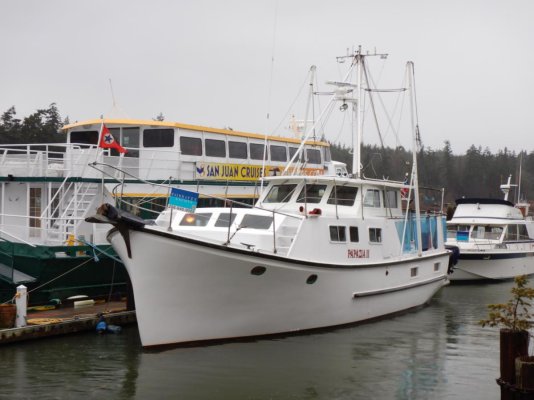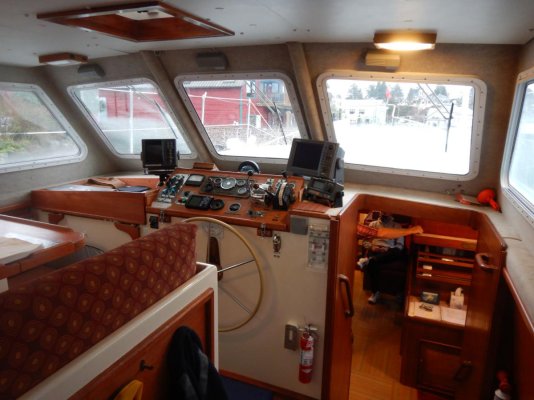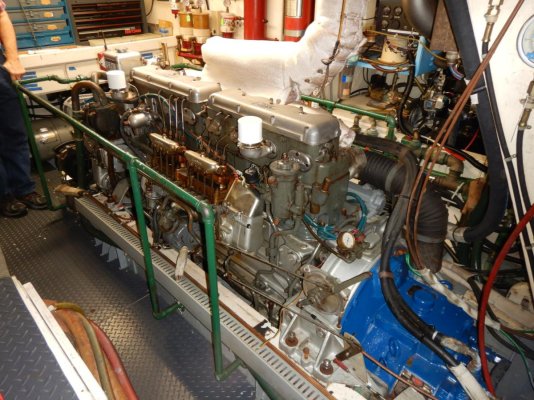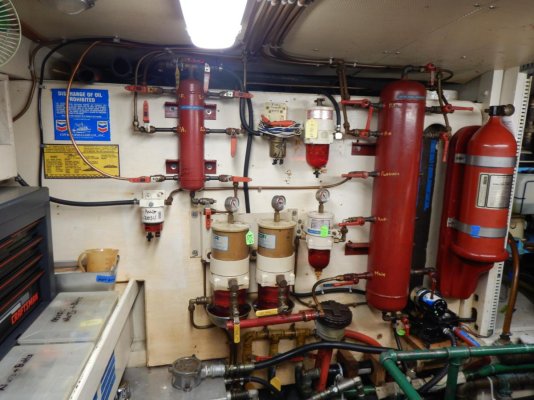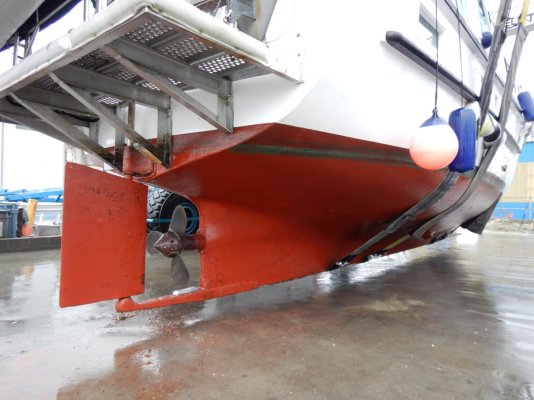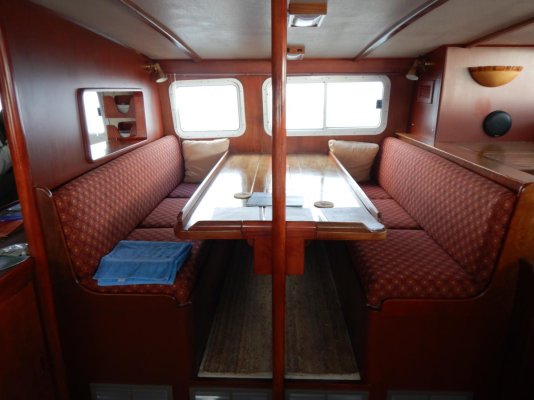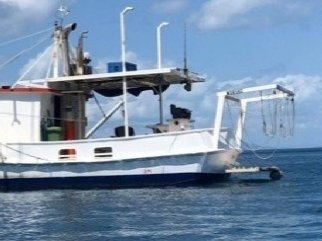You are using an out of date browser. It may not display this or other websites correctly.
You should upgrade or use an alternative browser.
You should upgrade or use an alternative browser.
what makes a trawler suitable for ocean crossings?
- Thread starter skyhawk
- Start date
The friendliest place on the web for anyone who enjoys boating.
If you have answers, please help by responding to the unanswered posts.
If you have answers, please help by responding to the unanswered posts.
READY
Guru
KnotYet: thanks for the encouraging words. I am not a pessimistic person but when it comes to boats I subscribe to the "what can go wrong will go wrong" theory. I just cannot convince myself that the stress of a pacific crossing would be worth it. If I ever decide to cover that much open water I will bite the bullet and ship her. For now my mid range cruising plans are up to the PNW. I did a trip from Seattle to Victoria in our express cruiser but have not been back in 25 years.
trawlercap
Senior Member
- Joined
- Aug 24, 2020
- Messages
- 294
- Location
- USA
- Vessel Name
- JoAhna K
- Vessel Make
- 58' Bill Garden Trawler 1952
William Garden designed this boat for passage making. The original design states "To take a family non-stop to the Galapagos." Big bow, small wheelhouse and windows back from the bow, small salon, low windage, wide walkways, high bulwarks topped with real handrails all the way around. Twin engine, Gen set, huge bank of batteries. 3,000 gallons fuel = 3,500 to 4,000 mile range. Real sea bunks deep in the hull. 131,000 lb displacement.
The ocean hasn't changed since this design in 1952. The market changed, demand for more interior room has pushed the house out to the edge of the boat. For doing the loop is just fine. For a sea? Side windows are venerable to getting slapped. And no way to walk around outside the boat.
Finally a real engine room. One you can walk in and inspect all your systems. filters exposed and easy to service. A manual engaged clutch to run a 2" emergency bilge pump off one main engine(if the the first two electric pumps fail) Big Hydraulic pumps run off other main engine. Back up systems built in, checked once a month to assure they operate. Bright and organized with more than standing head room.
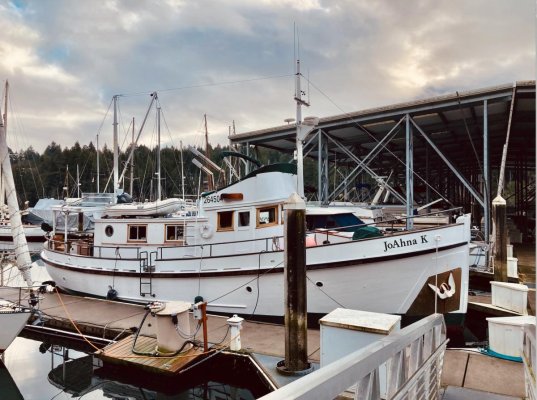
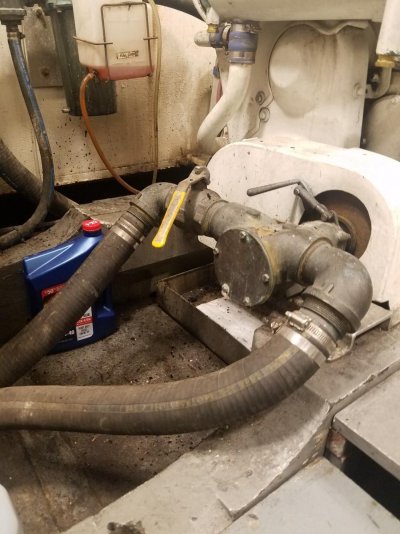
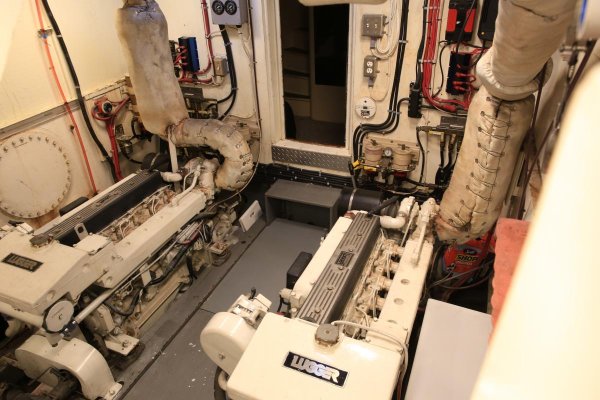
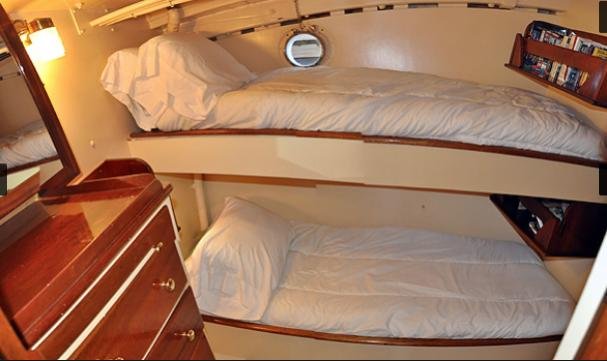
The ocean hasn't changed since this design in 1952. The market changed, demand for more interior room has pushed the house out to the edge of the boat. For doing the loop is just fine. For a sea? Side windows are venerable to getting slapped. And no way to walk around outside the boat.
Finally a real engine room. One you can walk in and inspect all your systems. filters exposed and easy to service. A manual engaged clutch to run a 2" emergency bilge pump off one main engine(if the the first two electric pumps fail) Big Hydraulic pumps run off other main engine. Back up systems built in, checked once a month to assure they operate. Bright and organized with more than standing head room.




Last edited:
There is the minimum requirement first.
-Comfortable with the redundancy of the boat.
-Comfortable that boat can be safe in 30' Seas for several hours.
-Comfortable boat has fuel range regardless of conditions so adequate reserve.
-No member of the crew must work more than 13 hours a day at a crew function. All members have a sleep period of at least 8 hours.
Now my ideal below:
-Enough speed that the longest run is 7-8 days. (not achievable with most trawlers). This puts you within 4 days of land at all times.
-With crew limitations from above, always at least 2 crew "on duty/working." This requires at least 4 crew members who can either take the helm or help on a watch. Beyond that, the more the better, but my preferred minimum for multi day 24 hour cruising is at least 4.
-Comfortable with the redundancy of the boat.
-Comfortable that boat can be safe in 30' Seas for several hours.
-Comfortable boat has fuel range regardless of conditions so adequate reserve.
-No member of the crew must work more than 13 hours a day at a crew function. All members have a sleep period of at least 8 hours.
Now my ideal below:
-Enough speed that the longest run is 7-8 days. (not achievable with most trawlers). This puts you within 4 days of land at all times.
-With crew limitations from above, always at least 2 crew "on duty/working." This requires at least 4 crew members who can either take the helm or help on a watch. Beyond that, the more the better, but my preferred minimum for multi day 24 hour cruising is at least 4.
mvweebles
Guru
- Joined
- Mar 21, 2019
- Messages
- 7,237
- Location
- United States
- Vessel Name
- Weebles
- Vessel Make
- 1970 Willard 36 Trawler
There is the minimum requirement first.
-Comfortable with the redundancy of the boat.
-Comfortable that boat can be safe in 30' Seas for several hours.
-Comfortable boat has fuel range regardless of conditions so adequate reserve.
-No member of the crew must work more than 13 hours a day at a crew function. All members have a sleep period of at least 8 hours.
Now my ideal below:
-Enough speed that the longest run is 7-8 days. (not achievable with most trawlers). This puts you within 4 days of land at all times.
-With crew limitations from above, always at least 2 crew "on duty/working." This requires at least 4 crew members who can either take the helm or help on a watch. Beyond that, the more the better, but my preferred minimum for multi day 24 hour cruising is at least 4.
You've described the use case for the Dashew FPB. Or something well over 100 feet long.
Back to the OP: What kind of boat to cross an ocean? Depends on which ocean and what time of year. If you don't have a schedule, are willing to bone-up on pilot charts, invest in access to weather, and develop the skills to interpret, a surprisingly modest boat will due as witnessed by the 1000's of boats that have done so safely. If you are unwilling/unable to mitigate weather risk, then you must plan for the worst possible weather. To my tastes, there is no ship large enough.
Peter
Last edited:
fgarriso
Guru
There is the minimum requirement first.
-Comfortable with the redundancy of the boat.
-Comfortable that boat can be safe in 30' Seas for several hours.
-Comfortable boat has fuel range regardless of conditions so adequate reserve.
-No member of the crew must work more than 13 hours a day at a crew function. All members have a sleep period of at least 8 hours.
Now my ideal below:
-Enough speed that the longest run is 7-8 days. (not achievable with most trawlers). This puts you within 4 days of land at all times.
-With crew limitations from above, always at least 2 crew "on duty/working." This requires at least 4 crew members who can either take the helm or help on a watch. Beyond that, the more the better, but my preferred minimum for multi day 24 hour cruising is at least 4.
*No member of the crew may work a shift longer than 6 hours with 12 hours off duty. With one helmsman and one person standing watch that makes 6 crew.
*All crew members bust be comfortable with 30' seas for 24 hours. Remember if they are sea sick they will not be able to take their shift.
*It doesn't matter how fast your boat is in rough seas you will by luckily to make 8 Knots headway. Even 100' ships have to slow down.
fgarriso
Guru
I forgot one thing on boat specifications.
The air intakes for the engine room on my boat are high and dry in all conditions. All deck level or lower intakes are blocked off and permatilty sealed.
The fresh air intake is aft and above the deckhouse going down to a 24"X24"X8" air box with a 24" 24 volt blower fan mounted in it blowing clean dry fresh air into the engine room with emergency dampers attached.
The exhaust air is going up and out just under the covered walkways overhead from the forward part of the engine room. Fresh air for the cabins, galley, and HVAC come from adjustable dorade boxes.
The air intakes for the engine room on my boat are high and dry in all conditions. All deck level or lower intakes are blocked off and permatilty sealed.
The fresh air intake is aft and above the deckhouse going down to a 24"X24"X8" air box with a 24" 24 volt blower fan mounted in it blowing clean dry fresh air into the engine room with emergency dampers attached.
The exhaust air is going up and out just under the covered walkways overhead from the forward part of the engine room. Fresh air for the cabins, galley, and HVAC come from adjustable dorade boxes.
balder8
Senior Member
- Joined
- Aug 15, 2018
- Messages
- 107
- Location
- France
- Vessel Name
- BALDER VIII
- Vessel Make
- North Sea Trawler 57' OC
I forgot one thing on boat specifications.
The air intakes for the engine room on my boat are high and dry in all conditions. All deck level or lower intakes are blocked off and permatilty sealed.
The fresh air intake is aft and above the deckhouse going down to a 24"X24"X8" air box with a 24" 24 volt blower fan mounted in it blowing clean dry fresh air into the engine room with emergency dampers attached.
The exhaust air is going up and out just under the covered walkways overhead from the forward part of the engine room. Fresh air for the cabins, galley, and HVAC come from adjustable dorade boxes.
Yes indeed! On my trawler, there is cheminey on the fly bridge which is provinding/ extracting fresh air to the engine room. Only one sea cock on the boat distributing sea water to the Northern Light genny, airco, seawater deck pump, water maker. No sea water in the main JD engine with the keel cooling Fernstrum hardware.
About crew, the major concern, at least.
No many choices or possibilities:
1 - cross Atlantic or Pacific with friends, I mean real friends. If you need 4 of them, will be a friendly communauty??? And will they be free at the same moment of departure?
2- ask for a professional skipper or crew. Not cheap but feasable with real pro ,means no bla bla bla ... Balance with shipping cost on a cargo?
3- like here in Las Palmas, go with young guys or girls, hippies or not dreaming to travel at low cost and looking for yachts.
For me, this is flirting with the disaster... Depending if you are lucky or super tolerant...
Not for a grumpy sailor like me!! To be honest, most of the times, they prefer jump on a sailing yacht than an heavy trawler!
2- ask for a professional skipper or crew. Not cheap but feasable with real pro ,means no bla bla bla ... Balance with shipping cost on a cargo?
Estimated cost of professional crew with at least one having experience on a crossing of this nature. Three professionals, two captains and a mate. Based on 14 days crossing.
Anticipated time $17,000 plus allowance for delays for weather so budget $22,000 plus fees and travel expenses to fly back home so total of $28,000 or so.
More time and stress on the boat than most get in a season. Crossing with professional crew is not a plan for saving money vs. shipping nor is crossing on your own really. It's like the chicken crossing the road. We do it to get to the other side in our own way.
Circumnavigator
Senior Member
Having crossed the Atlantic twice, once under sail and once on Fintry (pic to the left), as well as the Pacific and the Indian under sail, I think the comments above cover every requirement except one -- strong windows. Unless the boat was designed for ocean crossing, its windows will almost certainly not be strong enough to keep out green water, This is partly a matter of glass thickness (Fintry's are 1/2") but of the strength of the mounting. This is usually solved by having storm covers that bolt on over the existing windows. Replacing the windows themselves will cost several thousand dollars each. Either way -- storm covers or strong windows -- assumes that the boat itself has strong enough sides to stand being hit with a big wave. Most (dare I say all) production boats are not designed for ocean crossing.
As for distances, Bermuda doesn't help much. The Azores do. However, the shortest passages are northerly -- Scotland-Iceland_Greenland_Newfoundland has a longest leg between fuel of less than 800 miles. Any route farther south needs at least 1,200 miles -- and that's Azores to St. John's Newfoundland. Azores to Bermuda is 1,800 miles while Azores to Boston is 1,925.
Jim
As for distances, Bermuda doesn't help much. The Azores do. However, the shortest passages are northerly -- Scotland-Iceland_Greenland_Newfoundland has a longest leg between fuel of less than 800 miles. Any route farther south needs at least 1,200 miles -- and that's Azores to St. John's Newfoundland. Azores to Bermuda is 1,800 miles while Azores to Boston is 1,925.
Jim
FF
Guru
- Joined
- Oct 12, 2007
- Messages
- 22,552
With all the required differences between an inshore or along shore vessel, and a true passage maker its like comparing a motorcycle and a delivery van.
Sure either could do the others job , but not very well.
The inshore boat will be far better at cruising as fewer compromises will have been made to handle ocean work.
Sure either could do the others job , but not very well.
The inshore boat will be far better at cruising as fewer compromises will have been made to handle ocean work.
Fletcher500
Guru
Circumnavigator, you are one of a small group of people on this Forum that have crossed oceans on a boat. Good comments about windows. Mine would be blown out with big green water and hence another reason we are content coastal cruisers. Would like to hear more about your crossing on Fintry at some point in the future if you are so inclined.
OldDan1943
Guru
- Joined
- Oct 2, 2017
- Messages
- 10,599
- Location
- USA
- Vessel Name
- Kinja
- Vessel Make
- American Tug 34 #116 2008
Ah yes, coastal cruisers..... Do you realize 'they' are talking 200 mile out?
Hippocampus
Guru
- Joined
- Jul 27, 2020
- Messages
- 3,917
- Location
- Plymouth
- Vessel Name
- Hippocampus
- Vessel Make
- Nordic Tug 42
Been doing blue water for awhile. Several old saws have much truth and give you guidance for prep.
Keep the water out and crew in. End up with as many as you started with. Keep moving toward your destination.
Belt and suspenders for all key systems and stores.
You are not special. Everyone needs to be able to run the boat and fix what breaks.
If you didn’t bring it with you. You ain’t got it.
There’s only one captain.
Ocean doesn’t care who you are and what you’ve done just what you brought to the game now.
So going through some of things that follow from those old saws.
Water out means all features are designed to survive repetitive knock downs and boarding seas. Port lights have been discussed. In fact it’s the upwind side of the house at the deck junction that’s likely to fail in a knockdown. This is an important construction detail that can’t be retrofitted. Similarly replacing core with solid glass or G10 at stress points is never as good as solid and if needed backing plates at time of construction. Partially tabbed bulkheads are not as good as fully glassed in. Hull/deck juncture must be overbuilt as should all features in steering linkage. The list is huge but general idea of 2 to 3 strength to peak load margin needs to be built in at time of initial construction. A BWB is a totally different beast from keel to the top of the antennas. Have been on new and pricey power where I’ve seen oil canning in moderate conditions. People talk much boat disaster porn in extreme weather. My impression is most failures are in moderate persistent conditions with inadequate construction.
All aspects of the infill must be usable and suitable to function in a seaway. We had 7 berths according to the promo with the last boat. Really had 4 for passage. In a headsea the forward queen was useless. You’d be airborne 1/2 the time. The salon berths where functional with lee clothes. The quarterberths functional with a bungle board. The galley was C shaped so functional without getting burned most times. You put on your foulie bibs if it was really sporty. With door closed and feet pressed against it you where wedged when using the head. gentlemen sit. And so on. The overwhelming majority of sail and power isn’t suitable for activities of daily living on passage. If you store things behind things it gets to the point it’s such a PIA you forgo doing it. After a week or so you need discipline and a routine to stay clean, hydrated, fed and healthy. Health is a big deal. Inspite of carrying 200g of fresh and a watermaker we also carried enough gallons of jugs of water to have 3 g/d/person stored separately. Also enough food not requiring refrigeration to ensure 2000kcal/d/person. Also storm food(snicker bars and coke and such). It’s a huge list but basically if you want to end with the same number that you started with think of basic biology and belt and suspenders. Similarly our medi/surgical kit reflects that thinking.
As a kid I did some singlehanded and double handed races. Now want 4 aboard. Reason is sleep. Figure one will be a weak sister or sick or hurt. Leaves 3. 3 allows 4 h watches and 8 h sleep periods and time for personal hygiene, eating/drinking etc. I’ve done Norfolk to BVI several times with 3 but only when I’ve had big confidence in the other 2. Crew selection means writing a book to explain. No time now.
Need to do other stuff now. Real interested in other’s thoughts. Suspect there’s little difference in the attitude between power and sail. Will say other than being in my lover’s arms the happiest I’ve been is at sea. Endlessly fascinating and engaging. Only time you’re truly alone, all other aspects of life are irrelevant to your purpose and you have some measure of control of your destiny. Can’t truly describe the allure other than saying it’s addictive.
Keep the water out and crew in. End up with as many as you started with. Keep moving toward your destination.
Belt and suspenders for all key systems and stores.
You are not special. Everyone needs to be able to run the boat and fix what breaks.
If you didn’t bring it with you. You ain’t got it.
There’s only one captain.
Ocean doesn’t care who you are and what you’ve done just what you brought to the game now.
So going through some of things that follow from those old saws.
Water out means all features are designed to survive repetitive knock downs and boarding seas. Port lights have been discussed. In fact it’s the upwind side of the house at the deck junction that’s likely to fail in a knockdown. This is an important construction detail that can’t be retrofitted. Similarly replacing core with solid glass or G10 at stress points is never as good as solid and if needed backing plates at time of construction. Partially tabbed bulkheads are not as good as fully glassed in. Hull/deck juncture must be overbuilt as should all features in steering linkage. The list is huge but general idea of 2 to 3 strength to peak load margin needs to be built in at time of initial construction. A BWB is a totally different beast from keel to the top of the antennas. Have been on new and pricey power where I’ve seen oil canning in moderate conditions. People talk much boat disaster porn in extreme weather. My impression is most failures are in moderate persistent conditions with inadequate construction.
All aspects of the infill must be usable and suitable to function in a seaway. We had 7 berths according to the promo with the last boat. Really had 4 for passage. In a headsea the forward queen was useless. You’d be airborne 1/2 the time. The salon berths where functional with lee clothes. The quarterberths functional with a bungle board. The galley was C shaped so functional without getting burned most times. You put on your foulie bibs if it was really sporty. With door closed and feet pressed against it you where wedged when using the head. gentlemen sit. And so on. The overwhelming majority of sail and power isn’t suitable for activities of daily living on passage. If you store things behind things it gets to the point it’s such a PIA you forgo doing it. After a week or so you need discipline and a routine to stay clean, hydrated, fed and healthy. Health is a big deal. Inspite of carrying 200g of fresh and a watermaker we also carried enough gallons of jugs of water to have 3 g/d/person stored separately. Also enough food not requiring refrigeration to ensure 2000kcal/d/person. Also storm food(snicker bars and coke and such). It’s a huge list but basically if you want to end with the same number that you started with think of basic biology and belt and suspenders. Similarly our medi/surgical kit reflects that thinking.
As a kid I did some singlehanded and double handed races. Now want 4 aboard. Reason is sleep. Figure one will be a weak sister or sick or hurt. Leaves 3. 3 allows 4 h watches and 8 h sleep periods and time for personal hygiene, eating/drinking etc. I’ve done Norfolk to BVI several times with 3 but only when I’ve had big confidence in the other 2. Crew selection means writing a book to explain. No time now.
Need to do other stuff now. Real interested in other’s thoughts. Suspect there’s little difference in the attitude between power and sail. Will say other than being in my lover’s arms the happiest I’ve been is at sea. Endlessly fascinating and engaging. Only time you’re truly alone, all other aspects of life are irrelevant to your purpose and you have some measure of control of your destiny. Can’t truly describe the allure other than saying it’s addictive.
Last edited:
Cruising Sea Venture
Senior Member
- Joined
- Feb 14, 2018
- Messages
- 126
- Location
- United States
- Vessel Name
- Sea Venture
- Vessel Make
- 54' Cheoy Lee LRT
Lots of great comments here. We would recommend Beebe's "Voyaging Under Power" as well as mentioned above. It will give you an idea of what is different between a coastal cruisier and an ocean going power boat.
As owners of an ocean going power boat I would make sure that is really what you want?
If it's to cross an ocean (as in one), then do lots of coastal cruising, then maybe shipping is the best option.
If you plan to crisscross all over the place, then I would focus on a capable boat.
I say this because:
1) You are going to spend a lot more money on a well designed ocean going trawler then a coastal cruiser. It's not that there are a few differences - almost everything in the design will be different.
2) You are going to give up a lot of living space for tankage, redundancy, safety gear, etc.
Aboard our boat, Sea Venture, we have almost two of everything, literally.
Best of luck in your search,
Jim and Rosy Addington
M/V Sea Venture
www.CruisingSeaVenture.com
As owners of an ocean going power boat I would make sure that is really what you want?
If it's to cross an ocean (as in one), then do lots of coastal cruising, then maybe shipping is the best option.
If you plan to crisscross all over the place, then I would focus on a capable boat.
I say this because:
1) You are going to spend a lot more money on a well designed ocean going trawler then a coastal cruiser. It's not that there are a few differences - almost everything in the design will be different.
2) You are going to give up a lot of living space for tankage, redundancy, safety gear, etc.
Aboard our boat, Sea Venture, we have almost two of everything, literally.
Best of luck in your search,
Jim and Rosy Addington
M/V Sea Venture
www.CruisingSeaVenture.com
thanks everyone for some though provoking points!
As suspected, it's mostly just obvious stuff beyond the fuel range thing.... well that's obvious too I suppose
high bows/seaworthy design, stability, etc...
all stuff I already more or less know
But I suppose I did learn a few things so far to focus on....
What wasn't entirely obvious to me was what that range number really needs to be. Now I know various routes depending on season, etc... so I'm just head scratching ballpark numbers at this point
I've been looking at what a lot of folks have done in small sailing vessels along these lines and I recon MV cruising while similar can be a bit different.... that's the stuff I'm considering.
I like the idea of crisscrossing adventures, but I'm realistic enough to know that's not likely in the cards. At my age and given teh admiral's 'abilities' I know that the coastal cruising thing is much more of the interest...and I suppose there's enough here in the US to keep me happy but I know we both really would love to spend some serious time in Europe....maybe shipping something over makes some sense...or just buying something over there. Neither of those options appeal to me as much..... but definitely something I'll consider....
Regardless, if I ever were to do it I'd be looking very close and picking a good weather window to cross
I think I'll keep my eye out for a copy of those books, especially that Voyaging Under Power one...thanks
I'm a bit too early on in this what-ifing dream to really start looking at the Routing book....although that is part of the dream... just for curiosity I'd like to read more about the Northern route...short hops, Newfoundland, Greenland, Iceland, etc... but that's another topic for another thread I suppose....
As suspected, it's mostly just obvious stuff beyond the fuel range thing.... well that's obvious too I suppose
high bows/seaworthy design, stability, etc...
all stuff I already more or less know
But I suppose I did learn a few things so far to focus on....
What wasn't entirely obvious to me was what that range number really needs to be. Now I know various routes depending on season, etc... so I'm just head scratching ballpark numbers at this point
I've been looking at what a lot of folks have done in small sailing vessels along these lines and I recon MV cruising while similar can be a bit different.... that's the stuff I'm considering.
I don't know...I suppose the whole thing gets a bit tricky...something that can cross the atlantic but also coastal and canal or river cruise in europe might be a bit conflicting....depth of draft, air draft, etc...With all the required differences between an inshore or along shore vessel, and a true passage maker its like comparing a motorcycle and a delivery van.
Sure either could do the others job , but not very well.
The inshore boat will be far better at cruising as fewer compromises will have been made to handle ocean work.
I like the idea of crisscrossing adventures, but I'm realistic enough to know that's not likely in the cards. At my age and given teh admiral's 'abilities' I know that the coastal cruising thing is much more of the interest...and I suppose there's enough here in the US to keep me happy but I know we both really would love to spend some serious time in Europe....maybe shipping something over makes some sense...or just buying something over there. Neither of those options appeal to me as much..... but definitely something I'll consider....
Regardless, if I ever were to do it I'd be looking very close and picking a good weather window to cross
I think I'll keep my eye out for a copy of those books, especially that Voyaging Under Power one...thanks
I'm a bit too early on in this what-ifing dream to really start looking at the Routing book....although that is part of the dream... just for curiosity I'd like to read more about the Northern route...short hops, Newfoundland, Greenland, Iceland, etc... but that's another topic for another thread I suppose....
FF
Guru
- Joined
- Oct 12, 2007
- Messages
- 22,552
"I've been looking at what a lot of folks have done in small sailing vessels along these lines and I recon MV cruising while similar can be a bit different.... that's the stuff I'm considering."
The nature of a sailing vessel requires it to be far more robust to survive and even 20 fters have sailed the world.
Even small cruising sailboat can handle waves breaking on deck
Because both power and sail are boats does not make them both seaworthy.
The nature of a sailing vessel requires it to be far more robust to survive and even 20 fters have sailed the world.
Even small cruising sailboat can handle waves breaking on deck
Because both power and sail are boats does not make them both seaworthy.
Last edited:
Hippocampus
Guru
- Joined
- Jul 27, 2020
- Messages
- 3,917
- Location
- Plymouth
- Vessel Name
- Hippocampus
- Vessel Make
- Nordic Tug 42
FF yes and no. There are many 50’ sail I’d be reluctant to take out of site of land let alone helicopter distance (200m). Just like in power there’s a large # of boats intended for coastal use and a few BWB. Huge difference between the smaller bendytoys and a Bristol Channel Cutter.
sunchaser
Guru
- Joined
- Apr 9, 2008
- Messages
- 10,196
- Location
- usa
- Vessel Name
- sunchaser V
- Vessel Make
- DeFever 48 (sold)
Skyhawk
As has been shown countless times, crew knowledge and experience is an essential consideration. Dozens of differently configured motor vessels have been shown to successfully work for coastal and blue water passages.
As example, check out the vessels James Hamilton and Renee Douglas broke their teeth on in their early cruising days. Some great reading will provide the answers and describe their daunting travels.
As has been shown countless times, crew knowledge and experience is an essential consideration. Dozens of differently configured motor vessels have been shown to successfully work for coastal and blue water passages.
As example, check out the vessels James Hamilton and Renee Douglas broke their teeth on in their early cruising days. Some great reading will provide the answers and describe their daunting travels.
Yes, I certainly appreciate that...as well as knowledge, handiness, spare parts, planning, weather monitoring equipment, and so on
My original question though was meant more about the physical design/properties of a boat
Inother thread currently running asked about a Katy Krogen Manatee. One of teh 1st posts someone pointed out that because of the hull shape it's firmly in the coastal cruiser camp.... I had to look up what this boat looks like.
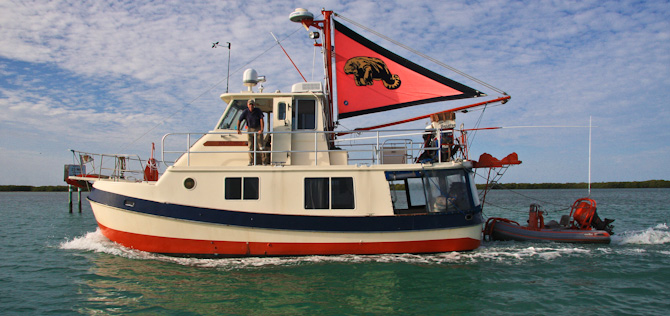
so yes, this is not the sort of boat I would empirically think would be a great crosser of big seas... can't see much...but high sides, big side windows, looks top heavy(I know...can't see what's under the water), no way to walk the sides to fend off piers or the many other reasons you might want safe side transit and access, bows are raised but not at all flaired....
Show me some examples and point out things that indicate it might cross an occasional ocean (with good weather planning) but still might be a great coastal cruiser ...maybe even suitable for some of the European rivers or canals (air draft seemingly important for that, so a mast that can step down, etc...) I know it wouldn't be ALL canals, as some require an incredibly low air draft and shallow water draft.....
My original question though was meant more about the physical design/properties of a boat
Inother thread currently running asked about a Katy Krogen Manatee. One of teh 1st posts someone pointed out that because of the hull shape it's firmly in the coastal cruiser camp.... I had to look up what this boat looks like.

so yes, this is not the sort of boat I would empirically think would be a great crosser of big seas... can't see much...but high sides, big side windows, looks top heavy(I know...can't see what's under the water), no way to walk the sides to fend off piers or the many other reasons you might want safe side transit and access, bows are raised but not at all flaired....
Show me some examples and point out things that indicate it might cross an occasional ocean (with good weather planning) but still might be a great coastal cruiser ...maybe even suitable for some of the European rivers or canals (air draft seemingly important for that, so a mast that can step down, etc...) I know it wouldn't be ALL canals, as some require an incredibly low air draft and shallow water draft.....
OldDan1943
Guru
- Joined
- Oct 2, 2017
- Messages
- 10,599
- Location
- USA
- Vessel Name
- Kinja
- Vessel Make
- American Tug 34 #116 2008
Yes, I certainly appreciate that...as well as knowledge, handiness, spare parts, planning, weather monitoring equipment, and so on
My original question though was meant more about the physical design/properties of a boat
Inother thread currently running asked about a Katy Krogen Manatee. One of teh 1st posts someone pointed out that because of the hull shape it's firmly in the coastal cruiser camp.... I had to look up what this boat looks like.

so yes, this is not the sort of boat I would empirically think would be a great crosser of big seas... can't see much...but high sides, big side windows, looks top heavy(I know...can't see what's under the water), no way to walk the sides to fend off piers or the many other reasons you might want safe side transit and access, bows are raised but not at all flaired....
Show me some examples and point out things that indicate it might cross an occasional ocean (with good weather planning) but still might be a great coastal cruiser ...maybe even suitable for some of the European rivers or canals (air draft seemingly important for that, so a mast that can step down, etc...) I know it wouldn't be ALL canals, as some require an incredibly low air draft and shallow water draft.....
It needs a door on both side of the saloon fwd to quick access the bow area.
Also many European canals require a narrow beam, I would guess.
IMO, a well designed walk around is not really necessary if there is access fwd and a cockpit. The midship cleats can be right outside the saloon doors.
My AT has a "hang on to rope" walk around. I would rather the saloon went the full width gaining maybe another 18 inches width internal or perhaps offset the saloon and capturing the excess space on the stbd side to promote a safer side deck. SHRUG
You have got to understand, each boat design has a CE rating when it comes out of the factory. What stuff you put on the boat deck will have an effect of the actual abilities.
I do not know the CE rating of the KKs.
Last edited:
- Joined
- May 11, 2019
- Messages
- 3,446
- Location
- United States
- Vessel Name
- Muirgen
- Vessel Make
- 50' Beebe Passagemaker
Show me some examples and point out things that indicate it might cross an occasional ocean (with good weather planning) but still might be a great coastal cruiser ...maybe even suitable for some of the European rivers or canals (air draft seemingly important for that, so a mast that can step down, etc...) I know it wouldn't be ALL canals, as some require an incredibly low air draft and shallow water draft.....
Our new to us boat. High bow, flared out, 4' railings all around, 2100 gallons of fuel, 1/2" tempered glass in ports, full walk around, 3 water tight compartments. Multiple de watering devices. Single Gardner with get home capability, 500 gal fresh water, paravanes, one through hull below water line, exterior rudder post, Berths for 6, 10 in a pinch. Accessibility everything mechanical w/o having to tear apart cabin sole/bulkheads. TONs of storage. Was originally designed to be French Canal capable, but Pilothouse was replaced with custom aluminum (fixed) as well as fixed mast. Designed by Robert Beebe (Hull 118). Built in the Philippines, brought home to PNW on her own bottom. Probably more than we need, but nice to have, and not need, than to need, and not have. Plan is 18 mo give or take in PNW and then down West Coast, thru Canal, to Keys/Bahamas in a leisurely manner. Not everyone's boat, but it'll do for us.

Attachments
OldDan1943
Guru
- Joined
- Oct 2, 2017
- Messages
- 10,599
- Location
- USA
- Vessel Name
- Kinja
- Vessel Make
- American Tug 34 #116 2008
Our new to us boat. High bow, flared out, 4' railings all around, 2100 gallons of fuel, 1/2" tempered glass in ports, full walk around, 3 water tight compartments. Multiple de watering devices. Single Gardner with get home capability, 500 gal fresh water, paravanes, one through hull below water line, exterior rudder post, Berths for 6, 10 in a pinch. Accessibility everything mechanical w/o having to tear apart cabin sole/bulkheads. TONs of storage. Was originally designed to be French Canal capable, but Pilothouse was replaced with custom aluminum (fixed) as well as fixed mast. Designed by Robert Beebe (Hull 118). Built in the Philippines, brought home to PNW on her own bottom. Probably more than we need, but nice to have, and not need, than to need, and not have. Plan is 18 mo give or take in PNW and then down West Coast, thru Canal, to Keys/Bahamas in a leisurely manner. Not everyone's boat, but it'll do for us.
I want!!
Do you have some interior pictures too?
OldDan1943
Guru
- Joined
- Oct 2, 2017
- Messages
- 10,599
- Location
- USA
- Vessel Name
- Kinja
- Vessel Make
- American Tug 34 #116 2008
Our new to us boat. High bow, flared out, 4' railings all around, 2100 gallons of fuel, 1/2" tempered glass in ports, full walk around, 3 water tight compartments. Multiple de watering devices. Single Gardner with get home capability, 500 gal fresh water, paravanes, one through hull below water line, exterior rudder post, Berths for 6, 10 in a pinch. Accessibility everything mechanical w/o having to tear apart cabin sole/bulkheads. TONs of storage. Was originally designed to be French Canal capable, but Pilothouse was replaced with custom aluminum (fixed) as well as fixed mast. Designed by Robert Beebe (Hull 118). Built in the Philippines, brought home to PNW on her own bottom. Probably more than we need, but nice to have, and not need, than to need, and not have. Plan is 18 mo give or take in PNW and then down West Coast, thru Canal, to Keys/Bahamas in a leisurely manner. Not everyone's boat, but it'll do for us.
You better chain that boat to the dock. If I find it and no one onboard, gone gone gone. LOL
- Joined
- May 11, 2019
- Messages
- 3,446
- Location
- United States
- Vessel Name
- Muirgen
- Vessel Make
- 50' Beebe Passagemaker
You better chain that boat to the dock. If I find it and no one onboard, gone gone gone. LOL
Here is the YW ad. We have lots of other pics as well, but here are a few to get you started!
https://www.yachtworld.com/boats/1982/custom-beebe-passagemaker-3683500/
Attachments
GoneDiving
Senior Member
"My boat has a cockpit with small drains and I always worry about it getting pooped if in a big breaking following sea. It also has a small door out to the swim platform so maybe if caught in that situation I should just leave the door open?"
The international fish boat folks have construction guides., mostly for 3rd world folks.
I believe they list cockpit drain times .
Plug up the scuppers put a hose in till water runs out over the side and unplug the drains and time the drain time.
This is a very radical test as wave action will probably shake much of the water out.
That would be an interesting test. My scuppers are so big that they have grizzly bars welded across to stop things/people being flushed out. ?
Attachments
David Ess
Senior Member
- Joined
- Dec 4, 2020
- Messages
- 392
Ive recently learned of trawlers that are only 59' long, but hold from 9k to 12k gallons of fuel. They dont say what their range is , nor even the discplaement of those steel hulled trawlers. Theyre designed for Alaskan waters, built in Oregon by Fred Wahl shipyard. Anybody out there know about these? Surely they would be good for long passages.
David Ess
Senior Member
- Joined
- Dec 4, 2020
- Messages
- 392
It needs a door on both side of the saloon fwd to quick access the bow area.
Also many European canals require a narrow beam, I would guess.
IMO, a well designed walk around is not really necessary if there is access fwd and a cockpit. The midship cleats can be right outside the saloon doors.
My AT has a "hang on to rope" walk around. I would rather the saloon went the full width gaining maybe another 18 inches width internal or perhaps offset the saloon and capturing the excess space on the stbd side to promote a safer side deck. SHRUG
You have got to understand, each boat design has a CE rating when it comes out of the factory. What stuff you put on the boat deck will have an effect of the actual abilities.
I do not know the CE rating of the KKs.
Some here dont accept even the highest CE rating of CE-A. Ive submitted some of them and people have mocked them , saying only good for coastal waters.
Not much discussion about engine exhaust systems. It is a critical factor in big seas. A wet exhaust system may work fine in most conditions but take 8’ seas over the stern for 24 hours and you could easy kill an engine or both. Now what? No power and you are quickly beam to. Then things go down hill fast. Dry exhaust will not be as much an issue, unless they break over that. And don’t think it can’t happen in a small boat .
rslifkin
Guru
- Joined
- Aug 20, 2019
- Messages
- 7,594
- Location
- USA
- Vessel Name
- Hour Glass
- Vessel Make
- Chris Craft 381 Catalina
Not much discussion about engine exhaust systems. It is a critical factor in big seas. A wet exhaust system may work fine in most conditions but take 8’ seas over the stern for 24 hours and you could easy kill an engine or both. Now what? No power and you are quickly beam to. Then things go down hill fast. Dry exhaust will not be as much an issue, unless they break over that. And don’t think it can’t happen in a small boat .
A poorly designed wet exhaust is definitely a liability in rough seas. But if the system is designed well, is hard to back flood an engine. If it's running, it's extremely hard.
Similar threads
Latest posts
-
-
-
-
-
-
-
Fixing boats in Exotic Places - are new boats really that bad?
- Latest: twistedtree
-

